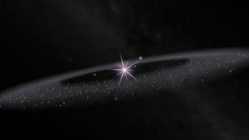It seems like there’s a strange gap in between Mars and Jupiter filled with rocky rubble. Why didn’t the asteroid belt form into a planet, like the rest of the Solar System?
Beyond the orbit of Mars lies the asteroid belt its a vast collection of rocks and ice, leftover from the formation of the solar system. It starts about 2 AU, ends around 4 AU. Objects in the asteroid belt range from tiny pebbles to Ceres at 950 km across.
Star Wars and other sci-fi has it all wrong. The objects here are hundreds of thousand of kilometers apart. There’d be absolutely no danger or tactical advantage to flying your spacecraft through it.
To begin with, there actually isn’t that much stuff in the asteroid belt. If you were to take the entire asteroid belt and form it into a single mass, it would only be about 4% of the mass of our Moon. Assuming a similar density, it would be smaller than Pluto’s moon Charon.
There’s a popular idea that perhaps there was a planet between Mars and Jupiter that exploded, or even collided with another planet. What if most of the debris was thrown out of the solar system, and the asteroid belt is what remains?
We know this isn’t the case for a few of reasons. First, any explosion or collision wouldn’t be powerful enough to throw material out of the Solar System. So if it were a former planet we’d actually see more debris.
Second, if all the asteroid belt bits came from a single planetary body, they would all be chemically similar. The chemical composition of Earth, Mars, Venus, etc are all unique because they formed in different regions of the solar system. Likewise, different asteroids have different chemical compositions, which means they must have formed in different regions of the asteroid belt. 
In fact, when we look at the chemical compositions of different asteroids we see that they can be grouped into different families, with each having a common origin. This gives us a clue as to why a planet didn’t form where the asteroid belt is.
If you arrange all the asteroids in order of their average distance from the Sun, you find they aren’t evenly distributed. Instead you find a bunch, then a gap, then a bunch more, then another gap, and so on. These gaps in the asteroid belt are known as Kirkwood gaps, and they occur at distances where an orbit would be in resonance with the orbit of Jupiter.
Jupiter’s gravity is so strong, that it makes asteroid orbits within the Kirkwood gaps unstable. It’s these gaps that prevented a single planetary body from forming in that region. So, because of Jupiter, asteroids formed into families of debris, rather than a single planetary body.
What do you think? What’s your favorite object in the asteroid belt. Tell us in the comments below.


Another nice video by Mr Cain.
The idea that the asteroid belt is the remnants of a planet is an old out-dated theory that would of died long ago were it not for the dubious observations and internet posts of bull*#it merchants like Richard Hoagland.
Modern ideas like the Nice Model and The Grand Tack have shown that it is almost certain that Jupiter migrated inwards, gobbling up material as it moved through the early solar system. This helps explain why there was never a planet between 2AU-4AU and why Mars is so small.
Were it not for Saturn’s mighty gravitational field, acting to pull Jupiter back, the solar system’s biggest planet might of plowed through the inner solar system and become “hot Jupiter”.
There are numerous problems with the basic assumption that the asteroids are “left-over” from the formation of the solar system. Most notably are the nickle-iron asteroids and the carbonaceous chondrites. The first is predominantly heavy metals, and the second is predominantly silicates. We would expect if the asteroids were just left-overs from the formation of the solar system, then the distribution of particles would be simply a molecular aggregate of molecules in relation to their formation, instead of the concentrated alloys that we observe.
This suggests that the asteroid belt was more probably a fully formed planet at one time in the past, where silicates concentrated in its crust, and heavier metals concentrated at its core, as we observe on earth. This planet was then impacted by an impactor of sufficient mass to shatter it. What we see as the asteroid belt is then the debris field of that impact residue.